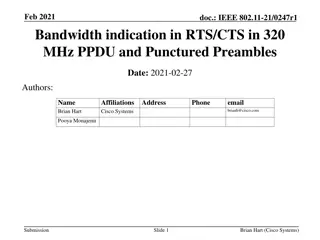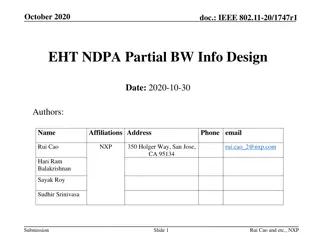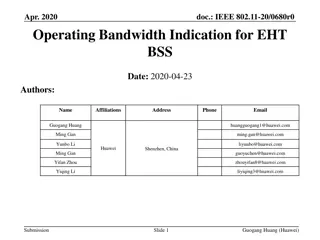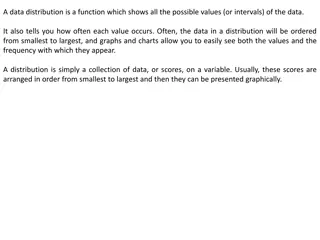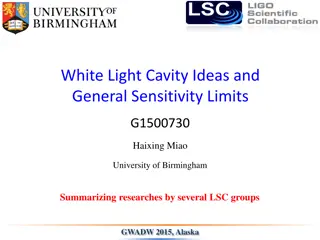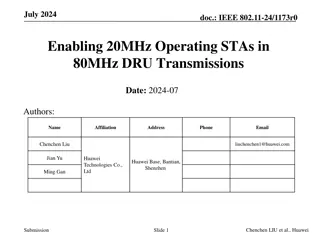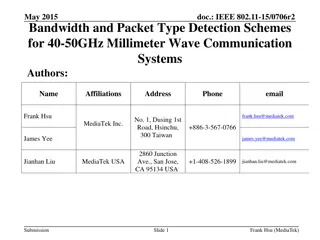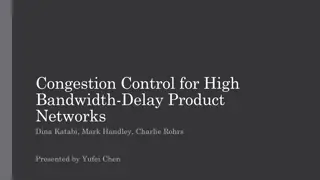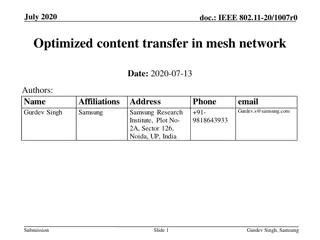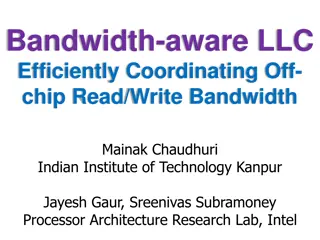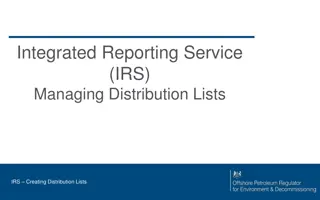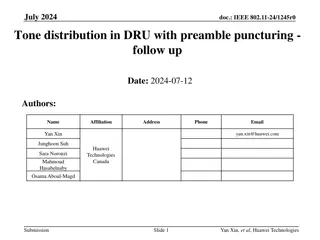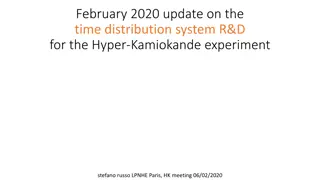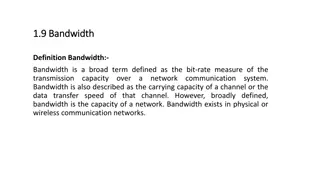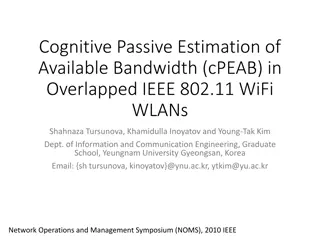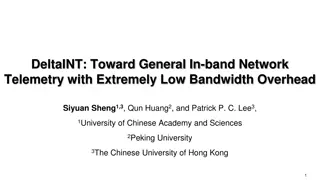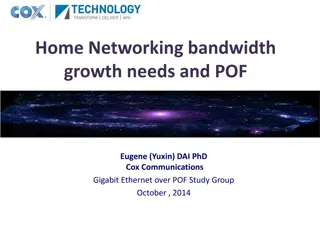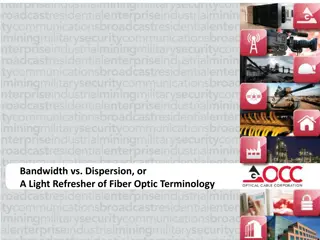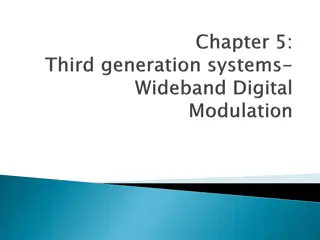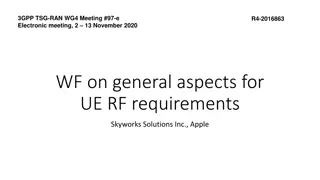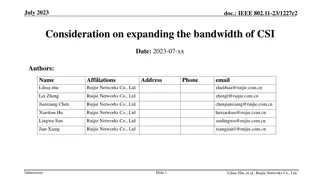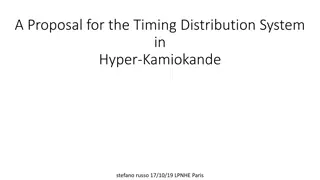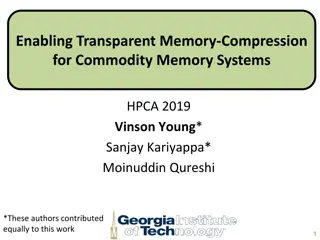Physical Distribution
Physical distribution is a critical aspect of business operations involving the planning, implementation, and control of the flow of goods from origin to consumer. Philip Kotler and William J. Stanton have defined physical distribution as a process of managing the movement of goods to meet consumer
0 views • 8 slides
Effective Management of Transportation and Distribution in the Supply Chain
Understanding the methods to optimize the supply chain through inventory management, basic functions of transportation and distribution management, distribution strategies, importance of creating visibility in transportation and distribution activities, and the role of technology in enhancing operat
6 views • 27 slides
IEEE 802.11-23/1288r0 Bandwidth Utilization Proposal
This proposal aims to improve bandwidth utilization in IEEE 802.11 networks by allowing devices to transmit on idle channels within the operating bandwidth. It addresses the inefficiencies caused by the current limitation where devices do not transmit on idle portions if the primary channel is busy.
2 views • 24 slides
Challenges and Requirements for Bandwidth Indication in IEEE 802.11
The document discusses challenges and requirements related to bandwidth indication in RTS/CTS frames with PPDU in 320 MHz, focusing on scenarios where bandwidth signaling may lead to misinterpretation by stations. It highlights the need for dynamic bandwidth and preamble puncturing information in RT
3 views • 21 slides
Design Considerations for Partial Bandwidth Information in IEEE 802.11-20/1747r1
Design considerations for partial bandwidth information in the IEEE 802.11-20/1747r1 standard are discussed, focusing on EHT NDPA frame structure, feedback mechanisms, bitmap design, and table-based designs to support large RU/MRUs. The feedback mechanism utilizes bitmap resolution signals, providin
1 views • 10 slides
Bandwidth Indication for EHT BSS in IEEE 802.11-20/0680r0
This IEEE document discusses the proposal to use an Enhanced High Throughput (EHT) operation element to indicate operating bandwidth for EHT Basic Service Sets (BSS). It suggests methods for indicating channel configurations, punctured channels, and channel width for EHT stations. The goal is to ena
0 views • 15 slides
Understanding Multinomial Distribution in Statistical Analysis
Multinomial Distribution is a powerful tool used in statistical analysis to model outcomes of events with multiple categories. This distribution is applied to scenarios where each trial has several possible outcomes, and the sum of probabilities of all outcomes is equal to 1. By defining random vari
0 views • 8 slides
Key Management and Distribution Techniques in Cryptography
In the realm of cryptography, effective key management and distribution are crucial for secure data exchange. This involves methods such as symmetric key distribution using symmetric or asymmetric encryption, as well as the distribution of public keys. The process typically includes establishing uni
1 views • 27 slides
Proposal for Efficient Bandwidth Utilization in IEEE 802.11 Networks
This proposal aims to address the inefficient utilization of bandwidth in IEEE 802.11 networks by allowing stations to transmit on idle channels within their operating bandwidth. The document discusses the problem statement, high-level solution, relevant capabilities of transmitters and receivers, p
0 views • 15 slides
Understanding Data Distribution and Normal Distribution
A data distribution represents values and frequencies in ordered data. The normal distribution is bell-shaped, symmetrical, and represents probabilities in a continuous manner. It's characterized by features like a single peak, symmetry around the mean, and standard deviation. The uniform distributi
1 views • 23 slides
Drug Product Distribution Procedures and Records
Written procedures and distribution records are crucial for the efficient distribution of drug products. Procedures should prioritize the distribution of the oldest approved stock first and enable easy recall if necessary. Distribution records must be maintained and indexed for accountability. Diffe
0 views • 10 slides
Understanding Normal Distribution and Its Business Applications
Normal distribution, also known as Gaussian distribution, is a symmetric probability distribution where data near the mean are more common. It is crucial in statistics as it fits various natural phenomena. This distribution is symmetric around the mean, with equal mean, median, and mode, and denser
1 views • 8 slides
IEEE 802.11 Proposal for 320MHz Ranging Enhancement
This document discusses the proposal for enhancing IEEE 802.11 with support for 320MHz bandwidth ranging operations. It aims to improve ranging accuracy by expanding 802.11az frames and procedures to accommodate the increased bandwidth. The focus is on MAC-related changes, exploring different option
2 views • 26 slides
Understanding Binomial Distribution in R Programming
Probability distributions play a crucial role in data analysis, with the binomial distribution being a key one in R. This distribution helps describe the number of successes in a fixed number of trials with two possible outcomes. Learn about the properties, probability computations, mean, variance,
3 views • 30 slides
Understanding Performance Analysis of Digital Modulation Techniques
Explore the realm of digital modulation techniques such as ASK, FSK, PSK, QPSK, QAM, and more. Learn about bandwidth efficiency, baud rates, minimum bandwidth, and how to calculate them. Discover the importance of M-ary modulation and how it impacts data transmission rates and bandwidth requirements
4 views • 18 slides
Advances in White Light Cavity for Sensitivity and Bandwidth Optimization
The research discusses innovative ideas for enhancing sensitivity and bandwidth limits in the context of white light cavity technologies. It explores methods such as external/internal squeezing and signal recycling to surpass existing Mizuno Limits, shedding light on crucial issues for future upgrad
0 views • 27 slides
Enhancing Memory Cache Efficiency with DRAM Compression Techniques
Explore the challenges faced by Moore's Law in relation to bandwidth limitations and the innovative solutions such as 3D-DRAM caches and compressed memory systems. Discover how compressing DRAM caches can improve bandwidth and capacity, leading to enhanced performance in memory-intensive application
0 views • 48 slides
Understanding Chi-Square and F-Distributions in Statistics
Diving into the world of statistical distributions, this content explores the chi-square distribution and its relationship with the normal distribution. It delves into how the chi-square distribution is related to the sampling distribution of variance, examines the F-distribution, and explains key c
0 views • 23 slides
Enhancing Support for Wider Bandwidth OFDMA in IEEE 802.11 Networks
The document discusses the implementation of Selective Spatial Transmission (SST) and Dynamic Subband Operation (DSO) to enable wider bandwidth OFDMA in IEEE 802.11be and 802.11bn standards. It covers enhancements for 80MHz, 160MHz, and 320MHz EHT DL and UL OFDMA transmissions, emphasizing the benef
0 views • 18 slides
Enabling 20MHz STAs in 80MHz DRU Transmissions
The document discusses the introduction, current solutions, and a proposed method for enabling 20MHz operating STAs to participate in 80MHz DRU transmissions. It addresses the challenges faced due to the uniform distribution of DRUs and proposes a subdivision approach to allow 20MHz STAs to efficien
0 views • 9 slides
IEEE 802.11-23/2141r0 Dynamic Subband Operation Discussion
Discussion on Dynamic Subband Operation in IEEE 802.11-23/2141r0 focusing on enabling flexible bandwidth allocation between APs and non-APs for improved resource utilization and system performance. The proposal aims to address bandwidth mismatches and enhance efficiency in channel access allocation
0 views • 15 slides
Bandwidth and Packet Type Detection Schemes for 40-50GHz Millimeter Wave Communication Systems
The document discusses bandwidth and packet type detection schemes for 40-50GHz millimeter wave communication systems in IEEE 802.11aj specifications. It proposes a preamble design for auto-detection of bandwidth and packet type to improve channel estimation and decoding efficiency. By utilizing dif
0 views • 27 slides
Congestion Control for High Bandwidth-Delay Product Networks
This presentation discusses the challenges faced by TCP in high bandwidth-delay product networks, highlighting issues such as oscillations and instability. It explores solutions like adjusting aggressiveness based on feedback delay, decoupling efficiency and fairness control, and introduces XCP as a
0 views • 23 slides
Optimized Content Transfer in Mesh Networks Using Bandwidth-Aware Chunking
This presentation by Gurdev Singh from Samsung addresses a technique for optimized content transfer in mesh networks by splitting content into file chunks based on the bandwidth of the channel. By considering the bandwidth or link quality of destination nodes, the content is divided so that lower ba
0 views • 20 slides
Enhancing Off-chip Bandwidth Utilization for Improved System Performance
Efficiently coordinating off-chip read/write bandwidth through the Bandwidth-aware LLC proposal yields a 12% performance improvement in an 8-core system across multiple workloads. This approach optimizes DRAM read latency, surpassing existing policies and filling performance gaps while confirming lo
1 views • 36 slides
Comprehensive Lesson on Distribution Planning and Setup
This detailed lesson plan covers essential aspects of distribution systems, planning, setups, layouts, and actors involved in the distribution cycle. Participants will learn about distribution types, considerations, and evaluation criteria to ensure successful distribution operations. The session in
0 views • 22 slides
Managing Distribution Lists in Integrated Reporting Service (IRS)
Integrated Reporting Service (IRS) allows users with Notification Submitter privileges to create distribution lists to inform interested parties about notifications submitted. Creating distribution lists saves time by eliminating the need to repeatedly enter email addresses, ensuring all relevant pa
0 views • 5 slides
Tone Distribution in DRU with Preamble Puncturing
The document discusses tone distribution in Distributed RU (DRU) with preamble puncturing in IEEE 802.11 networks. It explores the impact of preamble puncturing on subcarrier distribution and proposes solutions to optimize tone plans in DRU designs. Various rearrangements and tone distribution strat
1 views • 23 slides
Time Distribution System R&D Update for Hyper-Kamiokande Experiment
In the February 2020 update, Stefano Russo from LPNHE Paris presented the progress on the time distribution system R&D for the Hyper-Kamiokande experiment. The focus is on implementing a bidirectional data exchange link with a large bandwidth capacity for synchronous, phase-deterministic protocol. T
0 views • 17 slides
Understanding Bandwidth, Channel Capacity, and Noise in Communication Networks
Bandwidth is a crucial aspect of network capacity, describing the data transfer speed and carrying capacity of a channel. Channel capacity involves factors like data rate, bandwidth, noise, and error rate. Noise sources include thermal noise, impulse noise, and delay distortion, impacting signal qua
0 views • 5 slides
Cognitive Passive Estimation of Available Bandwidth in Overlapped IEEE 802.11 WiFi WLANs
Efficient bandwidth estimation is crucial for network management and QoS applications, with cognitive passive methods offering insights without additional traffic loads. This research explores the impact of control messaging overhead, network topology, channel usage, hidden/exposed terminals, and pa
0 views • 13 slides
DeltaINT: General In-band Network Telemetry with Low Bandwidth Overhead
This paper discusses DeltaINT, a novel framework for in-band network telemetry aimed at reducing bandwidth overhead while ensuring high generality and convergence. It addresses the limitations of existing methods by providing theoretical analysis on bandwidth mitigation guarantees and offering softw
0 views • 20 slides
Meeting Home Networking Bandwidth Needs with GEPOF Technology
Gigabit Ethernet over Polymer Optical Fiber (GEPOF) is a promising technology addressing the growing bandwidth requirements in home networking. Advances in FTTH technology enable high-speed connections for Smart Homes, supporting services like cloud computing, 4K video streaming, and Internet of Thi
0 views • 15 slides
Intelligent DRAM Cache Strategies for Bandwidth Optimization
Efficiently managing DRAM caches is crucial due to increasing memory demands and bandwidth limitations. Strategies like using DRAM as a cache, architectural considerations for large DRAM caches, and understanding replacement policies are explored in this study to enhance memory bandwidth and capacit
0 views • 23 slides
Understanding Bandwidth and Dispersion in Fiber Optic Communication
This presentation provides a comprehensive overview of bandwidth and dispersion in fiber optic communication. It covers essential terminologies like microns, nanometers, millimeters, and dB, explaining concepts such as bandwidth capacity, dispersion cancellation, and modal bandwidth in multimode fib
0 views • 24 slides
Evolution of Communication Systems: From Bandwidth Division to Spread Spectrum
Third-generation communication systems utilize Pseudo-Noise (PN) codes to share bandwidth without interference, while first and second-generation systems divide bandwidth into smaller channels. PN codes are vectors with 1s and -1s, orthogonal to each other. Users transmit data using PN coding, combi
0 views • 14 slides
Overview of UE RF Requirements for 35/45MHz Channel Bandwidth in 3GPP Meeting #97-e
The document discusses the introduction of 35/45MHz channel bandwidth in UE RF requirements for various bands. It covers equation-based requirements and limitations in UL configurations based on bandwidth allocation. The scope includes capturing content from the first round discussions and clarifyin
0 views • 16 slides
Enhancing Bandwidth of Channel State Information (CSI) for Wireless Sensing Applications
This submission delves into the necessity of expanding the bandwidth of Channel State Information (CSI) in wireless environments to cater to the demands of time-sensitive wireless sensing applications. It explores the implications of high-bandwidth CSI on enhancing wireless channel understanding, ac
0 views • 12 slides
Proposal for Timing Distribution System in Hyper-Kamiokande
A proposal for a timing distribution system in the Hyper-Kamiokande project, focusing on implementing a synchronous, phase-deterministic protocol with bidirectional data exchange. The system includes a master clock generator, atomic clock, and multiple distributors to synchronize various components.
0 views • 13 slides
Enhancing Memory Bandwidth with Transparent Memory Compression
This research focuses on enabling transparent memory compression for commodity memory systems to address the growing demand for memory bandwidth. By implementing hardware compression without relying on operating system support, the goal is to optimize memory capacity and bandwidth efficiently. The a
0 views • 34 slides



